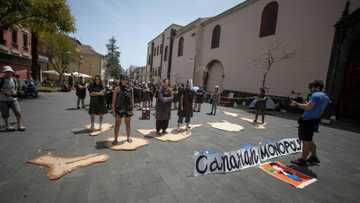Digital 'sleuths' fuel misinformation after Iran strikes

Source: AFP
Terrified onlookers crouch behind a wall as lights streak across the night sky in what self-proclaimed digital investigators claimed was footage of Iranian drones over Israel. But the video is months old, repurposed to sow misinformation.
Social media sites such as X, formerly Twitter, were swamped with misrepresented visuals after Iran launched an unprecedented wave of drones and missiles toward Israel at the weekend, exacerbating Middle East tensions during an ongoing war that has already seen a flood of misinformation.
Many of the falsehoods about the Iranian strikes were amplified by what researchers identified as accounts posing as "OSINT" -– or open-source intelligence -- investigators, feigning digital expertise to further blur the distinction between fact and fiction.
The trend, also prevalent in the Russia-Ukraine war and the Israel-Hamas conflict, highlights the potential for information chaos during a fast-unfolding crisis by just a handful of clout-chasing accounts, some of which appear to be monetizing misinformation on X.
"The fact that so much misinformation is being spread by accounts looking for clout or financial benefit is giving cover to even more nefarious actors," Isabelle Frances-Wright, director of technology at the nonprofit Institute for Strategic Dialogue (ISD), told AFP.
"The corrosion of the information landscape is undermining the ability of audiences to distinguish truth from falsehood on a terrible scale."
PAY ATTENTION: Let yourself be inspired by real people who go beyond the ordinary! Subscribe and watch our new shows on Briefly TV Life now!
ISD identified nearly three dozen false, misleading, or artificial intelligence-generated images and videos that claimed online to show the Iranian attack.
The posts received over 37 million views on X in the hours after Iran announced the strikes.
Amplified by algorithm
Contributing to the flood of misinformation, researchers said, was the Iranian state media which misrepresented old footage of wildfires in Chile to falsely claim it showed damage from the strikes in Israel.
But also substantially tainting the information landscape were accounts that came with "OSINT" or similar labels, apparently aimed at lending legitimacy to their posts.
They were among the users that misrepresented the video of people ducking for cover as footage from Iran's attack.
AFP's fact-checkers found the clip was filmed near a gas station in the Israeli city of Sderot in July 2023, when the army said it intercepted rockets fired from Gaza.
But the video rocketed across X, boosted by influential accounts such as "SprinterFactory," whom ISD researchers identified as one of the main spreaders of misinformation after Iran's attack.
The anonymous account, which uses a photo of a late Syrian general and frequently changes its handle on X, has built a major following while regularly amplifying falsehoods about the wars in Ukraine and Gaza as well as US President Joe Biden.
Many accounts peddling misinformation had purchased a blue checkmark on the Elon Musk-owned platform, allowing their content to be amplified by the site's algorithm.
After Musk's turbulent 2022 acquisition of X, the site introduced a paid verification system that researchers say has diminished its capacity for real-time sharing of authentic information and boosted conspiracy theorists.
'Noise to the discourse'
The blue check change is among a slew of contentious policies introduced by Musk that several misinformation experts say prioritize engagement over accuracy.
As well as restoring thousands of once-banned accounts, the platform rolled out an ad revenue-sharing program that appears to have created a financial incentive for verified users who spread hateful and false information.
That includes SprinterFactory and other "OSINT" influencers who are often seeking donations from their followers or profiting off their content.
"When combined with this pay-for-play amplification, the posting of misleading and inflammatory content allows these accounts to fill a vacuum of verified information in crisis events, further increasing their followings and influence," ISD's researchers said in a report.
The emergence of imposter OSINT accounts has complicated the work of credible researchers to such a degree that many of them now actively avoid the acronym to describe their work.
"When there's an account created in the last two years that uses OSINT in the title, you can generally safely assume they're a poseur who doesn't really know anything about the open-source investigation community," Eliot Higgins, from the digital investigative group Bellingcat, told AFP.
"It just adds more noise to the discourse around events," he told AFP.
PAY ATTENTION: Follow Briefly News on Twitter and never miss the hottest topics! Find us at @brieflyza!
Source: AFP




